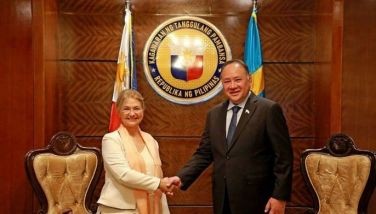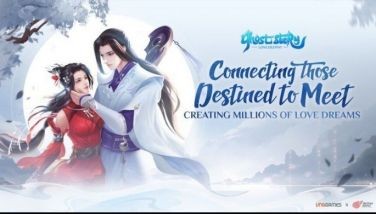Death of The Role Model
April 28, 2002 | 12:00am
This is an elegy to The Role Model. A person who was loved, revered, scorned, knocked off the pedestal, and is now being laid to rest. Let us say thanks for all that The Role Model has done, as well as for all that The Role Model did not do. And most importantly, let us reflect on what it was that brought on The Role Model’s demise, so that we may learn, so that we may never forget, and so we can find an excuse to orchestrate a memorable funeral.
The news came to me in a trickle. At first I couldn’t believe it, but after rounding up 15-20 college students and asking them, ‘Who is your role model and why?" (‘role model’ defined as someone whose life you admire and would like to emulate), I realized that there was no use holding on. It was time to bury the dead.
I thought it was simple enough. I counted on an assortment of ideas on the ‘role of the role model’ in the lives of today’s youth. The respondents I selected were from big-name universities, smaller colleges, a computer school, and a college in Davao City.
I went out there, sent out text messages, made phone calls. I asked the question clearly, resolutely, unconditionally. And yet, nearly all gave a clear, resolute and unconditional:
"Sorry, but I don’t have a role model," or "SORI BT I DNT HV A ROL MDL. CNT TINK OF ANY1 :( "
The other answers were interesting enough. Two, as expected, mentioned the late Rico Yan. One said Eminem because, despite his brushes with the law, he has the balls to speakâ€â€or rapâ€â€his mind. A girl said it was her mother, for putting up with her. And then there was one who said that his role model was Sen. Loren Legarda, before she decided to endorse a detergent soap.
Finally, someone actually said that his choice of role model depended on who was winning the current basketball season.
That was when I quoted WH Auden and said, "Bring out the coffin, let the mourners come."
The Role Model is no more.
I tried to make sense of it all. I discussed the issue with the genetically blessed 20-year-old Paolo Celestial, a handsome, talented, brilliant A-student from the Ateneo de Manila, who also happens to be my first cousin. He said: "I don’t think we have any role models. The media projects lifeless marketing mannequins to bait the unwary and exploitable. Ignorance is then cloaked in deference by pop culture."
Paolo hammered in the last nail on the coffin, so to speak.
I was then embarrassed at my naivete, my presumptuousness. I had misestimated my respondents. How could I have assumed that I would get responses like ‘Jose Rizal!’ ‘Ninoy Aquino!’ ‘The Pope!’ ‘Mother Teresa!’ or even ‘Miriam Quiambao!’ I thought that these were predictables and givens that would never change.
It turned out that I focused too much on the ‘models.’ What I had missed was that it was the ‘roles’ that have changed.
To be a role model implies that there is a role to be played, there is an ideal way of playing it, and that there is someone who fits the bill. Media, technology and westernization have all had a hand in changing the way we see social "roles" and the people who should fill them. Increased freedom and individuality have allowed people to "multi-task," thus giving birth to what the movie Zoolander called the "slashie," as in model–slash-actor.
The modern woman, for example, is a multiple slashie. She is mother/ wife/ career woman/ housekeeper/ friend/ daughter/ sister/ feminist. She may be ideal in one role (made her first million at age 28), but a complete disaster in another (her chocolate chip cookies taste like puto bumbong), but this is not the point. What matters is that she is able to fulfill all those duties, so that she can be considered a "complete woman."
Then there are those who make crossovers. These are the actors who turn into politicians (different from politicians who sometimes turn into actors on the campaign trail), the bank tellers who turn into beauty titleholders, the school teachers who turn into classroom vendors, the college professors who try to be newspaper columnists.
And of course there are those who have not only synergized roles, or reinvented roles, but those who have changed the way we look at the role completely, and thus alter society, as a whole, permanently. These are the roles that are supposed to require the highest moral character and unassailable integrity.
Let’s take a look at the Filipino presidency. Joseph Ejercito Estrada changed the role of the presidency foreverâ€â€or at least for as long as this generation of Filipinos chooses to remember. The gambler/ womanizer/ drinker/ actor /politician was anointed President by the will of the Filipino people as embodied in the democratic vote. Unlike the dictator Marcos, Erap was never "Presidential." He spoke bad English, drank too much, and was a college dropout. Like Cory, Erap was an underdog candidate, vastly different from the predecessor, a fountainhead of charisma, a symbol. But unlike Marcos and Cory, Erap was given the lowest expectations and was judged by the lowest of standards. By doing so, we lowered our standards for everything else.
When the highest office of the landâ€â€the most revered role modelâ€â€is besmirched in this manner, you can expect the rest of society, like the deck of cards in Alice and Wonderland, to follow suit.
The Politician and the Civil Servant are never the same again.
The Actor is never the same again.
The Father, The Husband, and The Wedding Principal Sponsor are never the same again.
But what preceded this? Could it be that the Role Model was already dead before this happenedâ€â€long before Erap was declared President, long before he declared himself to be free from relatives, friends and fellow godparents?
When was that time when someone quietly declared "The Role Model is dead; long live the Image Model!"?
Let us turn our eyes away from the stoutness of Estrada and look at our own malnutrition.
For the longest time we had history, and we had history books. We had monuments and tombstones and shrines and museums. Historical figures were few and far between, lionized by their larger-than-life deeds and words, shrouded by legend and myth.
Then television and satellite broadcast were invented, and that was gone with the wind.
Now, as Andy Warhol had predicted, it is just as easy to create celebrity as it is to dethrone celebrity. You don’t need to be crucified upside down for a tabloid to canonize you a saint. You don’t need talent to win a Golden Globe. You don’t need military rank to bomb a skyscraper. You may not need IQ if you have charisma.
Thus, despite the possible sincerity of their intentions, many of our celebrities are no longer considered role models, but rather as image models. In a time when being a public figure means being a media figure, when it is not a matter of what you’re made of but what you project, it is the triumph of style over substance. The right packaging, after all, can turn any regular yumburger into The Champ.
The Role Model is dead, and the media has blood in its hands, for sure. But if media is also a mere mirror of society, then who is the real assassin? Who shot the heroes?
A society that does not know how to revere the right heroes properly can only expect each new generation to become more prematurely cynical than the last. Our irreverence is reflected in our contradictions: We proclaim Ninoy Aquino to be a martyr while the Marcoses are being reelected. We call our OFW’s our new heroes while the family unit disintegrates. It is like Mad Max in Thunderdome, at the rate we’re going: "We don’t need another hero!"
Our media-bombarded youth can see right through this. They’ve seen too many squeaky clean idols pushed off their pedestals. They’ve witnessed the drug-sex-money scandals even in the most hallowed places. They don’t bother with The Role Model, who no longer sells, but only more often disappoints. And in this consumerist age, kids would loathe to grow up to be some broke and obscure Role Model.
The Image Model gets the media mileage, the public sympathy, the top-of-mind privilege, the all-access pass, the astronomical talent fees. The Image Model gets the fan clubs and the websites. In the happy ending, the Image Model gets the girl (or the guy, for that matter.)
In Lifestyle, the Image Model rules. And in Deathstyle, well, there is no greater honor than to be buried a Role Model.
I thought it was simple enough. I counted on an assortment of ideas on the ‘role of the role model’ in the lives of today’s youth. The respondents I selected were from big-name universities, smaller colleges, a computer school, and a college in Davao City.
I went out there, sent out text messages, made phone calls. I asked the question clearly, resolutely, unconditionally. And yet, nearly all gave a clear, resolute and unconditional:
"Sorry, but I don’t have a role model," or "SORI BT I DNT HV A ROL MDL. CNT TINK OF ANY1 :( "
The other answers were interesting enough. Two, as expected, mentioned the late Rico Yan. One said Eminem because, despite his brushes with the law, he has the balls to speakâ€â€or rapâ€â€his mind. A girl said it was her mother, for putting up with her. And then there was one who said that his role model was Sen. Loren Legarda, before she decided to endorse a detergent soap.
Finally, someone actually said that his choice of role model depended on who was winning the current basketball season.
That was when I quoted WH Auden and said, "Bring out the coffin, let the mourners come."
The Role Model is no more.
I tried to make sense of it all. I discussed the issue with the genetically blessed 20-year-old Paolo Celestial, a handsome, talented, brilliant A-student from the Ateneo de Manila, who also happens to be my first cousin. He said: "I don’t think we have any role models. The media projects lifeless marketing mannequins to bait the unwary and exploitable. Ignorance is then cloaked in deference by pop culture."
Paolo hammered in the last nail on the coffin, so to speak.
I was then embarrassed at my naivete, my presumptuousness. I had misestimated my respondents. How could I have assumed that I would get responses like ‘Jose Rizal!’ ‘Ninoy Aquino!’ ‘The Pope!’ ‘Mother Teresa!’ or even ‘Miriam Quiambao!’ I thought that these were predictables and givens that would never change.
It turned out that I focused too much on the ‘models.’ What I had missed was that it was the ‘roles’ that have changed.
The modern woman, for example, is a multiple slashie. She is mother/ wife/ career woman/ housekeeper/ friend/ daughter/ sister/ feminist. She may be ideal in one role (made her first million at age 28), but a complete disaster in another (her chocolate chip cookies taste like puto bumbong), but this is not the point. What matters is that she is able to fulfill all those duties, so that she can be considered a "complete woman."
Then there are those who make crossovers. These are the actors who turn into politicians (different from politicians who sometimes turn into actors on the campaign trail), the bank tellers who turn into beauty titleholders, the school teachers who turn into classroom vendors, the college professors who try to be newspaper columnists.
And of course there are those who have not only synergized roles, or reinvented roles, but those who have changed the way we look at the role completely, and thus alter society, as a whole, permanently. These are the roles that are supposed to require the highest moral character and unassailable integrity.
Let’s take a look at the Filipino presidency. Joseph Ejercito Estrada changed the role of the presidency foreverâ€â€or at least for as long as this generation of Filipinos chooses to remember. The gambler/ womanizer/ drinker/ actor /politician was anointed President by the will of the Filipino people as embodied in the democratic vote. Unlike the dictator Marcos, Erap was never "Presidential." He spoke bad English, drank too much, and was a college dropout. Like Cory, Erap was an underdog candidate, vastly different from the predecessor, a fountainhead of charisma, a symbol. But unlike Marcos and Cory, Erap was given the lowest expectations and was judged by the lowest of standards. By doing so, we lowered our standards for everything else.
When the highest office of the landâ€â€the most revered role modelâ€â€is besmirched in this manner, you can expect the rest of society, like the deck of cards in Alice and Wonderland, to follow suit.
The Politician and the Civil Servant are never the same again.
The Actor is never the same again.
The Father, The Husband, and The Wedding Principal Sponsor are never the same again.
But what preceded this? Could it be that the Role Model was already dead before this happenedâ€â€long before Erap was declared President, long before he declared himself to be free from relatives, friends and fellow godparents?
When was that time when someone quietly declared "The Role Model is dead; long live the Image Model!"?
For the longest time we had history, and we had history books. We had monuments and tombstones and shrines and museums. Historical figures were few and far between, lionized by their larger-than-life deeds and words, shrouded by legend and myth.
Then television and satellite broadcast were invented, and that was gone with the wind.
Now, as Andy Warhol had predicted, it is just as easy to create celebrity as it is to dethrone celebrity. You don’t need to be crucified upside down for a tabloid to canonize you a saint. You don’t need talent to win a Golden Globe. You don’t need military rank to bomb a skyscraper. You may not need IQ if you have charisma.
Thus, despite the possible sincerity of their intentions, many of our celebrities are no longer considered role models, but rather as image models. In a time when being a public figure means being a media figure, when it is not a matter of what you’re made of but what you project, it is the triumph of style over substance. The right packaging, after all, can turn any regular yumburger into The Champ.
The Role Model is dead, and the media has blood in its hands, for sure. But if media is also a mere mirror of society, then who is the real assassin? Who shot the heroes?
A society that does not know how to revere the right heroes properly can only expect each new generation to become more prematurely cynical than the last. Our irreverence is reflected in our contradictions: We proclaim Ninoy Aquino to be a martyr while the Marcoses are being reelected. We call our OFW’s our new heroes while the family unit disintegrates. It is like Mad Max in Thunderdome, at the rate we’re going: "We don’t need another hero!"
Our media-bombarded youth can see right through this. They’ve seen too many squeaky clean idols pushed off their pedestals. They’ve witnessed the drug-sex-money scandals even in the most hallowed places. They don’t bother with The Role Model, who no longer sells, but only more often disappoints. And in this consumerist age, kids would loathe to grow up to be some broke and obscure Role Model.
The Image Model gets the media mileage, the public sympathy, the top-of-mind privilege, the all-access pass, the astronomical talent fees. The Image Model gets the fan clubs and the websites. In the happy ending, the Image Model gets the girl (or the guy, for that matter.)
In Lifestyle, the Image Model rules. And in Deathstyle, well, there is no greater honor than to be buried a Role Model.
BrandSpace Articles
<
>

















